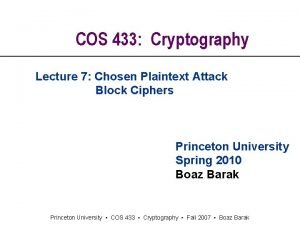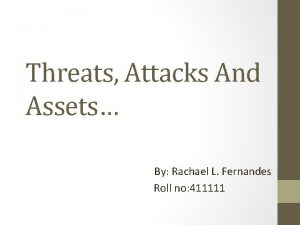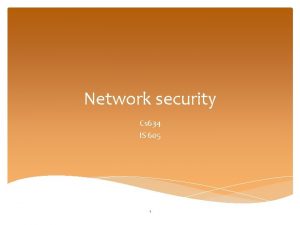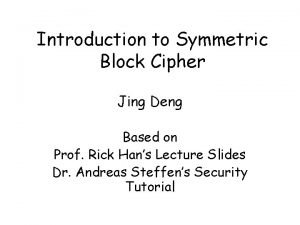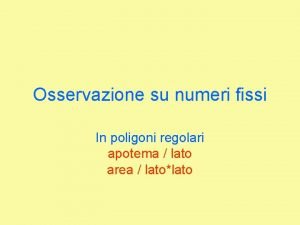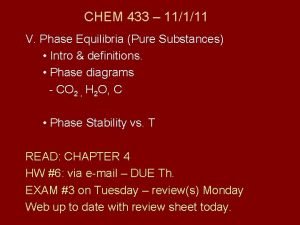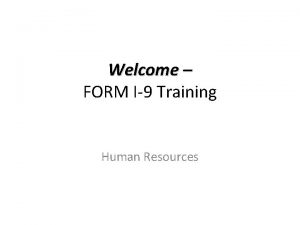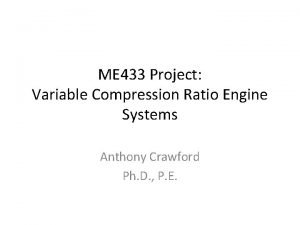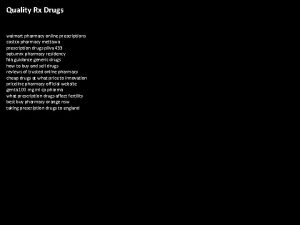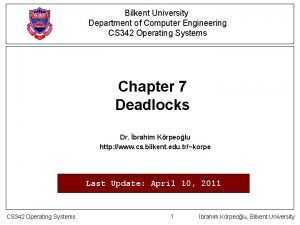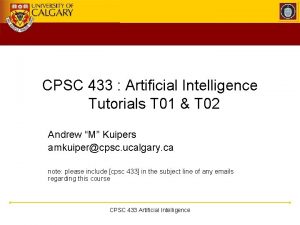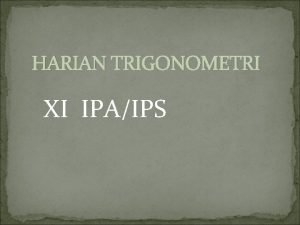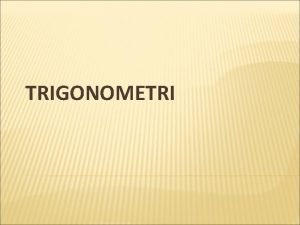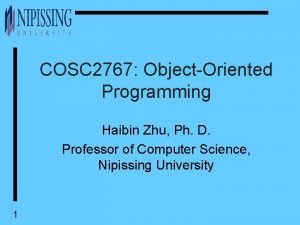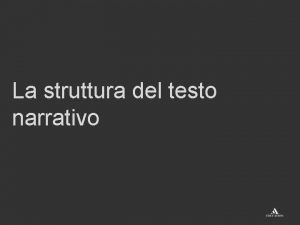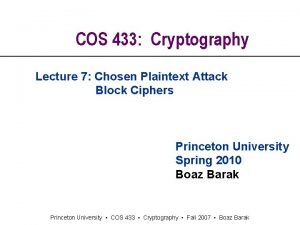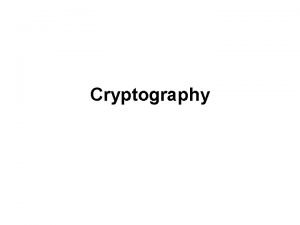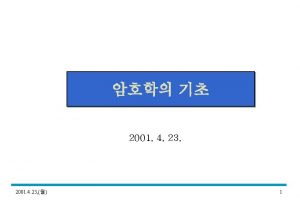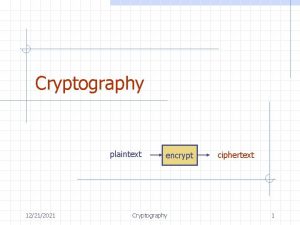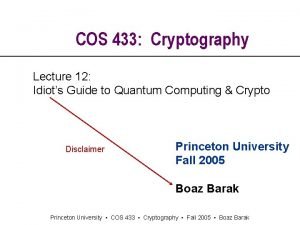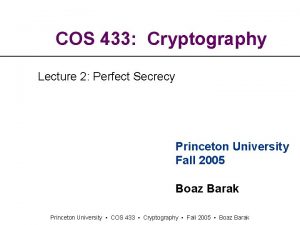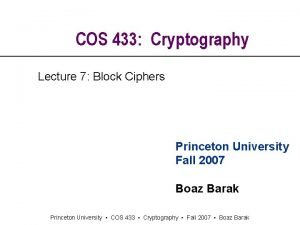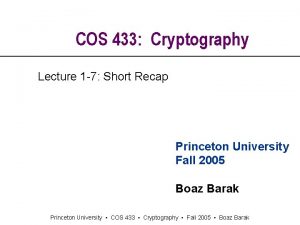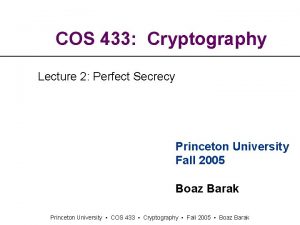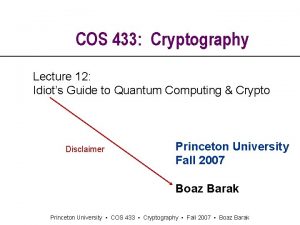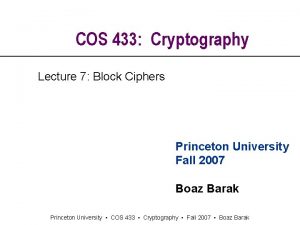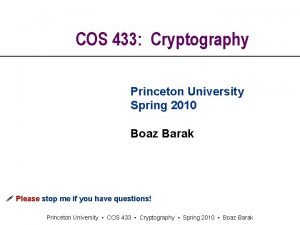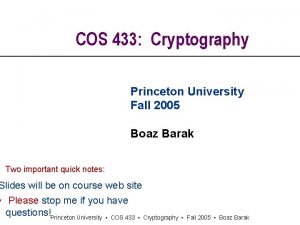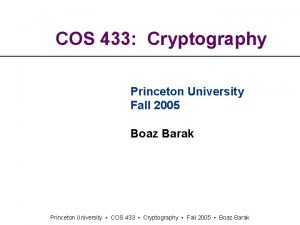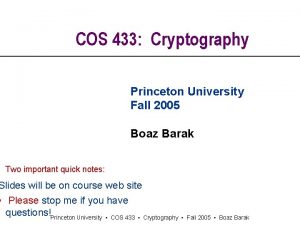COS 433 Cryptography Lecture 7 Chosen Plaintext Attack






















- Slides: 22

COS 433: Cryptography Lecture 7: Chosen Plaintext Attack Block Ciphers Princeton University Spring 2010 Boaz Barak Princeton University • COS 433 • Cryptography • Fall 2007 • Boaz Barak

Short Review of PRF construction G fs(x) Snapshot after i invocations. 2

Short Review of PRF construction G Hi Hi+1 fs(x) Adv Hi Hi+1 3

Chosen Plaintext Attack (CPA) So far our security notion is: encrypt one message and die. Def: (E, D) is CPA secure, if for all poly-bounded Eve, Pr[ Eve wins in CPA game] < ½+negligble Encryption phase: Eve Challenge phase: In words: Eve gets to see encryptions of messages of her choice, before attempting to break encryption too conservative? 4

Achieving CPA Security Eve 5

Achieving CPA Security Eve 6

Recall: Pseudo-Random Block Cipher Functions (PRF) { fs } is PRF, if (s, x) fs(x) is efficiently computable and no efficient adv. can tell apart black-box access to v fs(¢) for random s 2 r {0, 1}n v random F: {0, 1}n New notion: Pseudorandom Permutations (PRP) Another name for PRP: a block cipher. { Ek } is PRP, if both (k, x) Ek(x) and (k, y) Ek-1(y) are efficiently computable and no efficient adv. can tell apart access to: v Ek(¢) and Ek-1(¢) for random k 2 r {0, 1}n v random permutation F: {0, 1}n and F-1 PRP can be based on Axiom 1 (through PRF) but also have many practical candidates called block ciphers 7

Block Cipher { Ek } is PRP, if both (k, x) Ek(x) and (k, y) Ek-1(y) are efficiently computable and no efficient adv. can tell apart access to: v Ek(¢) and Ek-1(¢) for random k 2 r {0, 1}n v random permutation F: {0, 1}n and F-1 Another name for PRP: a block cipher. (BS book: “strong block cipher”) Despite name is not secure encryption by itself. (deterministic) However, yields CPA-secure encryption with essentially any form of random padding (see exercise). Often used in practice as an encryption by itself. This is OK if input has high entropy (e. g. , not a “yes or no” msg). Several practical candidates. Note: not all security properties equally well studied. 8

History Data Encryption Standard - DES § 1972: NIST (then NBS) call for encryption standard proposals. § IBM response: “Lucifer”. § NSA tweaked Lucifer to get DES § Short key (56 Conspiracy? bits) Backdoors? Mysterious “S boxes” § 1970’s: Diffie&Hellman suggest $20 M machine to find key within a day. § 1990’s: Wiener suggest $1 M machine to find key within 3. 5 hours. § 1997: Over the Internet ~50 K machines find key in 90 days. § 1998: $210 K machine “deep crack” finds key in 56 hours. § By late 90’s most commercial applications use 3 DES – three applications of DES with independent keys 9

History Skipjack and the Clipper Chip § 1993: US Govt suggests to give industry a chip (called “clipper”) containing NSA-developed cipher “Skipjack”. § Clipper has 3 keys: v F – family key shared among all chips hardwired & secret, v U – unit key – one per chip, split among 2 federal agencies: F Choose random U 1 and U 2=U©U 1 v K – session key – chosen by user. § For each session chip computes LEAF=EF( id info , EU(K) ). Refuses to decrypt without LEAF. § Was not very popular. § 1998: Skipjack declassified. § Weakness found by Biham, Biryokuv, Shamir. 10

History Advanced Encryption Standard (AES) § 1997: Call for replacement to DES § Goals: v use for ¸ 30 years , protect info for 100 years. v strong at least as 3 DES, significantly more efficient. § International, open competition. § Winner: Rijndael (Daeman, Rijmen Belgium) § Block length: 128 bits, key length: 128, 192 or 256 bits § Efficiency: v Hardware implementations up to ~50 Gbit/second v Software: 251 cycles/block (2 cycles/bit) ~ 1 Gbit/sec on 2 Ghz Pentium 4 11

AES Rijndael - Operation § Block: 128 bits = 16 bytes (4 x 4 square) § Key: 128 bits expanded using PRG to 10 keys k 1, …, k 9 each 128 bits size (9 – number of rounds, more for larger keys) § Components: v S-box: “random” function S: [256] implemented by lookup (actual function explicit, avoid fear of trapdoor) v A: a special 4 x 4 byte matrix (chosen for fast computation) § Operation: repeat for 9 times (i. e. , rounds): v XOR ki with plaintext v Run S-box on each byte v Shift rows v Matrix-multiply plaintext with A (mix columns) § To decrypt do everything backwards (replace A with A-1) 12

AES Rijndael – Round Function XOR key x 1, 1 x 1, 2 x 1, 3 x 1, 4 k 1, 1 k 1, 2 k 1, 3 k 1, 4 x 2, 1 x 2, 2 x 2, 3 x 2, 4 k 2, 1 k 2, 2 k 2, 3 k 2, 4 x 3, 1 x 3, 2 x 3, 3 x 3, 4 k 3, 1 k 3, 2 k 3, 3 k 3, 4 x 4, 1 x 4, 2 x 4, 3 x 4, 4 k 4, 1 k 4, 2 k 4, 3 k 4, 4 Apply S Box Shift rows Matrix multiply / Mix columns © x 1, 1 x 1, 2 x 1, 3 x 1, 4 x 2, 1 x 2, 2 x 2, 3 x 2, 4 x 3, 1 x 3, 2 x 3, 3 x 3, 4 x 4, 1 x 4, 2 x 4, 3 x 4, 4 x 1, 1 x 1, 2 x 1, 3 x 1, 4 x 2, 2 x 2, 3 x 2, 4 x 2, 1 x 3, 2 X 3, 4 x 3, 1 x 3, 2 x 4, 4 x 4, 1 x 4, 2 x 4, 3 A 13

Security for Block Ciphers Formal definition: block-cipher = pseudorandom permutation. In practice: Sometimes need less, sometimes need more. Block-ciphers typically not based on number-theoretic problem such as factoring integers, etc. . (Although assume NP P) Confidence in block ciphers gained through cryptanalysis. Typical question: How many known (or chosen) plaintext/ciphertext pairs and computation steps are needed to find key. Block cipher has known weakness if there’s such attack taking less than 2 key length resources. Block cipher is broken if there’s such attack taking a feasible amount of resources. 14

Cryptoanalysis – Historical Example FEAL - Shimizu and Miyaguchi, NTT § Architecture similar to DES, slightly larger key (64 bits) § First version – 4 rounds proposed in 1987 § 1988: 100 -10, 000 msgs chosen-plaintext attack found. § Later improved to only 20 chosen msgs § Next version – FEAL-8 : 8 rounds § 10, 000 chosen plaintexts attack § Later attacks: v ~30 K known plaintext attack for FEAL-8 v 5 known plaintext attack for FEAL-4 v Better than brute force attack for FEAL-N for any N<32. 15

Differential Cryptanalysis § In 1991, Biham & Shamir presented a general method to attack DESlike systems. § Is not extremely successful for DES itself (248 operations instead of 256). § Works very well for subtle variants: v Random S-boxes : 237 known plaintext attack v G-DES (Schaumuller-Bichl, 81): 6 known plaintext attack! § Insight on (then secret) design criteria of DES. 16

How to Choose A Block Cipher Common heuristic: Choose fastest unbroken cipher. Problem: unbroken means not known to be broken. § Perhaps will be broken in future. § Perhaps no one really tried to break it. My (non-expert) suggestion: Choose a secure cipher that is efficient enough. Secure means public and well-studied. Does not mean: § Cipher with no known attacks (# analysts < # ciphers) § Your own homebrewed cipher with only copy of specs under pillow. (especially if you { Biham, Rivest, Shamir, …} ) § A secret government-made military cipher. 17

Modes of Operation for Block-Ciphers A block cipher is a pseudorandom permutation Ek: {0, 1}n. A mode of operation extends the cipher to inputs larger than n. (typically integer multiples of n) Many modes with different efficiency and security properties. Examples: • ECB – Electronic Code-Book mode • CBC – Cipher-Block-Chaining • CTR – Counter mode. { Ek } is PRP, if both (k, x) Ek(x) and (k, y) Ek-1(y) are efficiently computable and no efficient adv. can tell apart access to: v Ek(¢) and Ek-1(¢) for random k 2 r {0, 1}n v random permutation F: {0, 1}n and F-1 18

ECB – Electronic Codebook Mode Simplest mode: E’k(x 1, . . , xm) = Ek(x 1), …, Ek(xm) x 1 x 2 x 3 Ek Ek Ek y 1 y 2 y 3 Efficient: § On-line computation. § Can recover if one block got lost/corrupted in transit. Problem Can reveal structure of message (e. g. whether x 1=x 3 or not) w/ security: 19

CBC – Cipher-Block-Chaining Mode Let IV 2 {0, 1}n be some string. Define: c 0 = IV, ci = Ek(ci-1 © xi) , E’k(x 1, …, xm) = c 0, c 1, …, cm IV x 1 x 2 x 3 © © © Ek Ek Ek y 1 y 2 y 3 Efficient: § On-line computation. § If one block got lost/corrupted lose only next block Secure: If IV is random then this is CPA-secure (exercise) 20

Counter Mode Define: r 1 = Ek(1), r 2= Ek(2), … Use r 1, r 2, r 3, … as a pad. That is: sender keeps state i, to encrypt x do: §i i+1 § Send (i , Ek(i) © x) Security: relies on following observations: § If {Ek} is a PRP then it is also a PRF. § If { fs} is a PRF then G(s) = fs(0)fs(1)fs(2)…fs(m) is a PRG. 21

Recommended Reading § BS Chapters 4, 5 §Eli Biham’s lecture on block ciphers. § See web site for more material and food for thought. 22
 Chosen-plaintext attack
Chosen-plaintext attack Active attack and passive attack
Active attack and passive attack Is 605
Is 605 Plaintext ciphertext
Plaintext ciphertext 01:640:244 lecture notes - lecture 15: plat, idah, farad
01:640:244 lecture notes - lecture 15: plat, idah, farad Numeri fissi dei poligoni regolari
Numeri fissi dei poligoni regolari Chem 433
Chem 433 Tutti i poligoni regolari
Tutti i poligoni regolari I9 training
I9 training Me 433
Me 433 Hdl-mhrcu.433
Hdl-mhrcu.433 How to transfer prescription to costco
How to transfer prescription to costco Cs 342 bilkent
Cs 342 bilkent Securingthehuman sans org
Securingthehuman sans org Cpsc 433
Cpsc 433 Lied 433
Lied 433 Sin 112 1/2
Sin 112 1/2 Sin 6 berapa derajat
Sin 6 berapa derajat Intreccio e fabula
Intreccio e fabula Tentukan nilai trigonometri sudut berikut cosec 315 derajat
Tentukan nilai trigonometri sudut berikut cosec 315 derajat Cos c -cos d formula
Cos c -cos d formula Come riconoscere le sequenze in un testo
Come riconoscere le sequenze in un testo Bentuk sederhana dari 2 cos 80 sin 50 adalah
Bentuk sederhana dari 2 cos 80 sin 50 adalah
